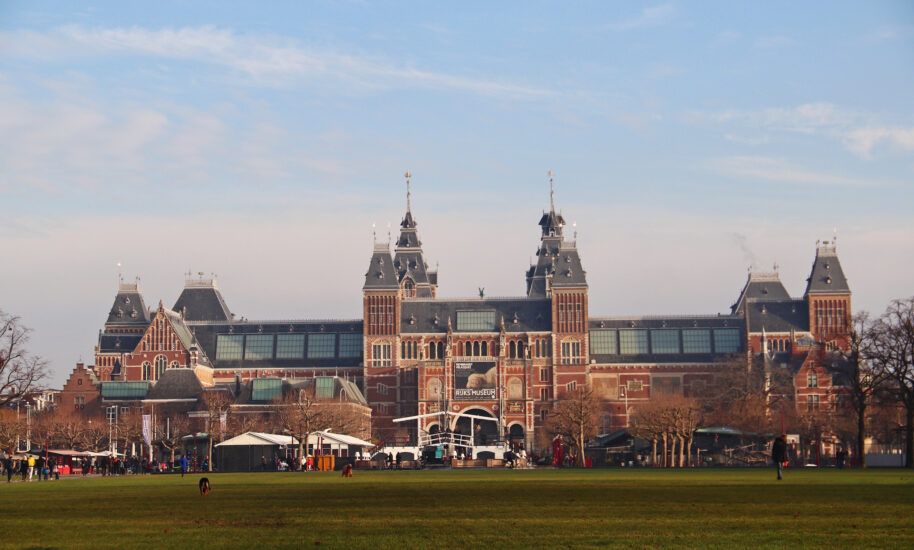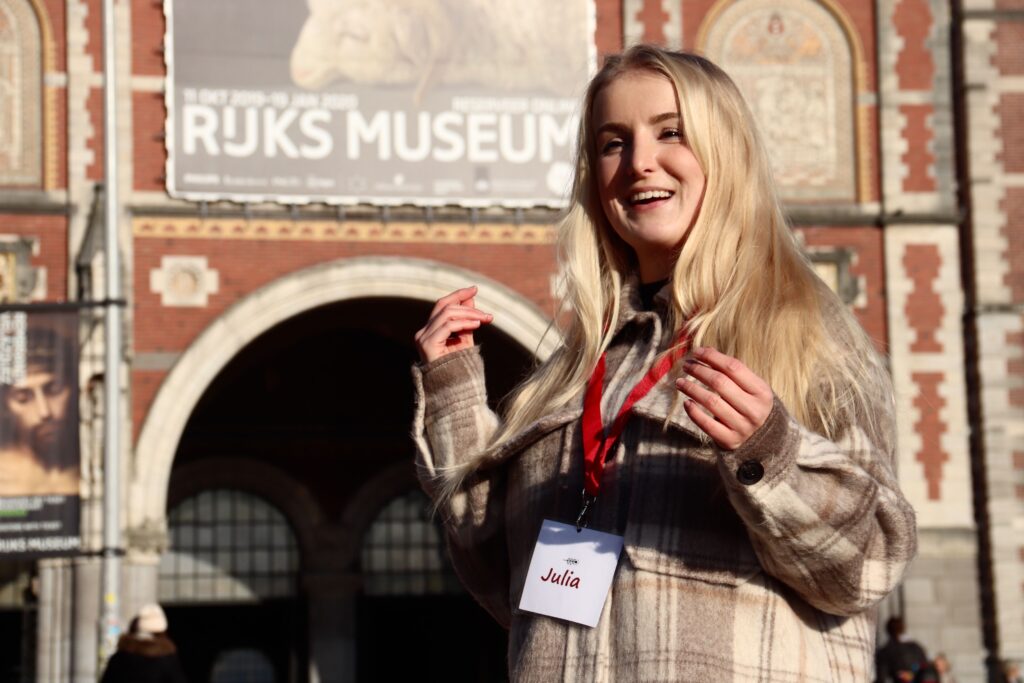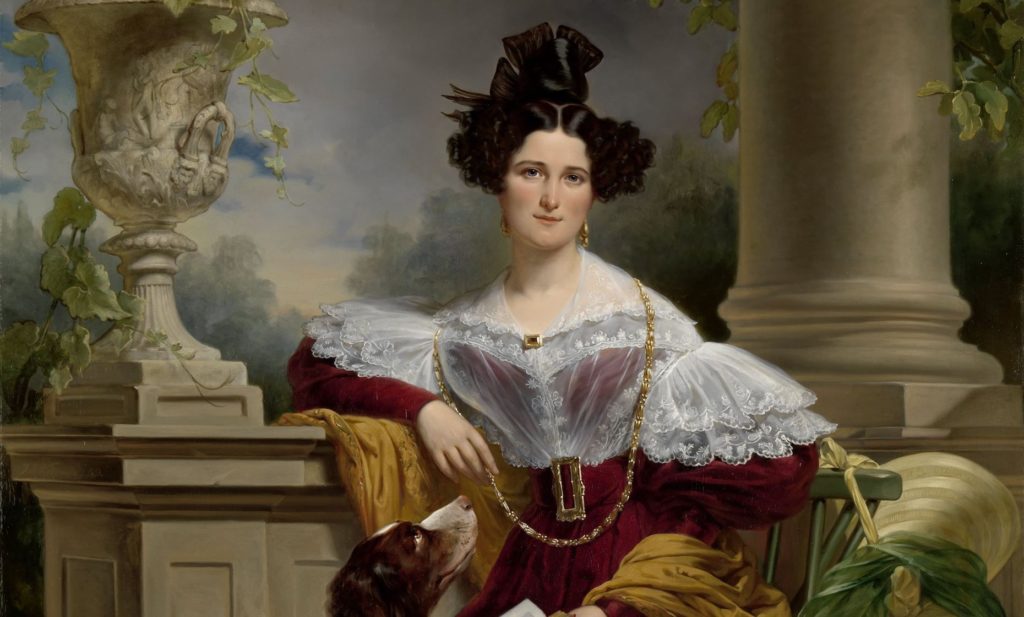Rijksmuseum: The Golden Age and Rembrandt

Few buildings in Amsterdam are as imposing as the Rijksmuseum – or are so often mistaken for the Central Station. Don’t worry, you’re not alone. In fact, both buildings were built at the same time around the turn of the century in the same style (the “Amsterdam School”) by the same architect and are now impressive landmarks of Amsterdam. However, while one is the main point of interest for all travellers, the other is home to the oldest art-historical works in the Netherlands. From Rembrandt to Vermeer, the most famous works and treasures of the entire country can be found here – in the original, of course.
The Rijksmuseum is a museum of diversity. Of course, you’ll mainly see modern works of art here, but there are also all sorts of hallows of Dutch history on display. If you are visiting us for the first time in beautiful Amsterdam, then a visit is particularly worthwhile, as the Rijksmuseum has the largest collection of Dutch art history in the entire country! What’s more, the visit is a great winter activity and offers you a few hours of cosy shelter from the cold and wet weather that many tourists are still getting used to 😉.
Find out what else makes the Rijksmuseum so special and what secrets you can uncover there!

The history of the Rijksmuseum
The history of the Rijksmuseum does not actually begin in Amsterdam, but in The Hague in 1800. The impressive collection of Dutch art then moved several more times until it finally moved into its final home in 1885: the Rijksmuseum in Amsterdam. Unlike other museums, however, the Rijksmuseum building was not converted into a museum at a later date. No, it was built as a museum for a single purpose and that was to create a worthy location for Rembrandt’s Night Watch! This is a good illustration of the artist’s value to the Netherlands. It is not for nothing that he is considered one of the most famous and successful artists in the Netherlands alongside Van Gogh and Vermeer. But as they all deserve their place in the Rijksmuseum, you will find works by all three of them there.
The architecture of the Rijksmuseum is an interesting mix of Renaissance and Gothic. The Dutch architect Pierre Cuypers added all kinds of typical Dutch details in the spirit of the time. In the Rijksmuseum you will discover many ornaments and sculptures that were typical of the colonial period and the Golden Age.
The perfect building to provide a home for contemporary works. The Rijksmuseum’s focus is clearly on the Golden Age, the heyday of which can be roughly placed between 1650 and 1750. During this period, the Netherlands became one of (if not THE) most important trading nations in the world. As born seafarers, the Dutch embraced the international currents and conquered large parts of the world, which naturally also brought the finest raw materials with them. These in turn brought the trade goods to Europe with which the Netherlands became really rich. Would you like to know what these goods were? Or find out why this supposedly golden age was also one of the most critical and terrible for the indigenous population? You’ll find the answers on our Rijksmuseum tour or cultural city centre tour!

Rembrandt: The star of the Rijksmuseum
If an artist’s surname is enough to make the whole world take notice, then you’ve probably made it. However, it is even more impressive when someone’s first name becomes the talk of the town. This is also the case with Rembrandt van Rijn, as the impressive Dutch artist was born. He lived in the 17th century and is considered one of the most important artists in the Netherlands during the Golden Age. The painter from the Dutch city of Leiden was particularly fond of the classical Baroque style. From 1631, Rembrandt came to Amsterdam, where his works would later be uniquely exhibited.
It all started with portraits, which incidentally made Rembrandt very rich. It was presumably from the proceeds that he was able to buy the large house in the Jewish quarter that bears his name today. It was not until 18 years later, however, that Rembrandt completed his most famous work, the “Night Watch” for the Amsterdam vigilantes. You can also see other Rembrandt works and artworks by many of his Dutch colleagues in the Rijksmuseum: Vermeer, Van Gogh, Asselijn…

Why a guided tour of the Rijksmuseum is worthwhile
When you look at the more than 8,000 exhibits that the Rijksmuseum is home to, it’s easy to lose sight of the forest for the trees. If you want to get the most out of your visit to the Rijksmuseum, you should therefore consider taking part in a guided tour. Not only will you get exciting information that the explanatory panels won’t tell you, but you’ll also be able to see all the highlights in just 1.5 hours. So you get more information than the museum itself provides. At the same time, you can relax on the tour and listen to your guide, who will explain everything to you in detail.
But the best thing is: all your burning questions can be answered on your tour! You are guaranteed to take away more than just exploring the museum on your own. Don’t worry, you will of course have time to do this after your tour. Conveniently, you can stay in the museum for as long as you like afterwards and go back to your favourite pieces. The perfect museum day is already pre-programmed. 😊

The hidden Cuypers library
In a building as steeped in history as the Rijksmuseum, written knowledge is of course a must! Not only are important books on display here, but they also have a library built especially for them, where they can be presented and read. The library is located in the east wing of the museum and is spread over several floors. It is considered to be the largest and oldest art history library in the Netherlands, so it is definitely worth a visit! It is accessible to students, visitors and anyone else who wants to see it. Even for those who are not deeply interested in art history. The library is a sight to behold and tells its very own story even without (written) words. It’s a must-see if you’re ever in the Rijksmuseum. If you have any doubts about finding the library on your own, you can simply ask the museum guide for the tour 😉.

